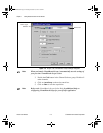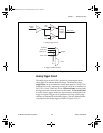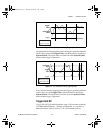
Chapter 2 Hardware Overview
NI 5911 User Manual 2-6
©
National Instruments Corporation
Like any other type of converter that uses noise shaping to enhance
resolution, the frequency response of the converter is only flat to its
maximum useful bandwidth. The NI 5911 has a bandwidth of 4 MHz.
Beyond this frequency, there is a span where the converter acts resonant and
where a signal is amplified before being converted. These signals are
attenuated in the subsequent digital filter to prevent aliasing. However, if
the applied signal contains major signal components in this frequency
range, such as harmonics or noise, the converter may overload and signal
data will be invalid. In this case, you will receive an error signaling
overload. You then need to either select a higher input range or attenuate
the signal.
Acquisition System
The NI 5911 acquisition system controls the way samples are acquired and
stored. It is possible for the NI 5911 to acquire data at different rates and
resolutions. There are two sampling methods available in oscilloscope
mode, Real Time and Repetitive (RIS). Using Real Time sampling, you can
acquire data at a rate of 100 MS/n where n is a number from 1 to 4.3
million. RIS sampling can be used on repetitive signals to effectively
extend the sampling rate above 100 MS/s. In RIS mode, you can sample at
rates of 100 MS/s * n where n is a number from 2 to 10. The available
Table 2-2.
Available Sampling Rates and Corresponding Bandwidth in
Flexible Resolution Mode
Sampling Rate Resolution Bandwidth
12.5 MS/s 12 bits 4 MHz
5 MS/s 14 bits 2 MHz
2.5 MS/s 16 bits 800 kHz
1 MS/s 18 bits 400 kHz
500 MS/s 18 bits 200 kHz
200 MS/s 19 bits 80 kHz
100 MS/s 19 bits 40 kHz
50 MS/s 20 bits 20 kHz
20 MS/s 20 bits 8 kHz
10 MS/s 21 bits 4 kHz
CBIHWum.book Page 6 Thursday, October 29, 1998 1:56 PM


















